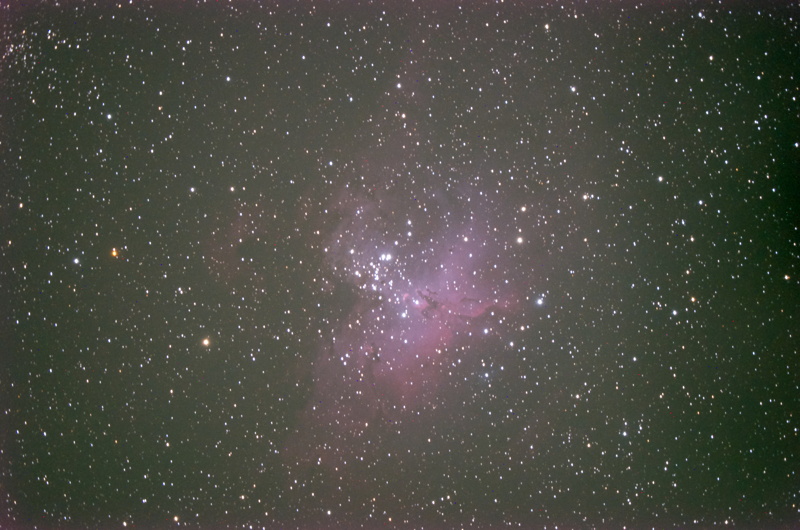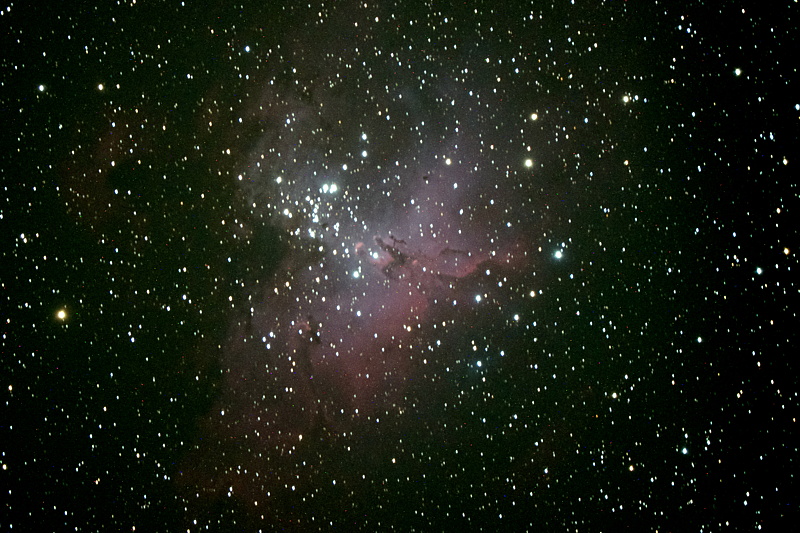Crescent Moon, M16 Exposure Tests, Comet C/2014 E2 Jacques
Posted: 28 August 2014
Cloudy skies returned on Sunday, 24 August. Had a nice monsoon thunderstorm on Tuesday, 26 August, with 0.74" total rain in a little over one hour. No leaks in the POD, even after 5 years of use. Monsoon 2014 seems to be winding down and Wednesday, 27 August, the skies began to clear as sunset approached.
|
Opened: Wednesday, 27 August 2014, 1843 MST Temperature: 93°F |
Session: 711 Conditions: Mostly clear, high humidity |
1849 MST: saw the thin crescent moon in 7x50 finderscope, but could not see in 8" telescope at 83X. I began to wonder if I had forgotten to set the proper focus at the end of the previous session. Tried to view Saturn, Mars, and Antares before sunset; no luck. 1854 MST: sunset. 1859 MST: got Antares in 8"; it was way out of focus. 1900 MST: moon, 83X. Set up for iPhone afocal imaging using my modified MX-1 afocal adapter. This image was taken at 1911 MST, 77X:

1927 MST: did some lunar observing, 83X. This D7000 DSLR shows the thin crescent moon just above the trees at 1930 MST:

At 1935 MST, I took this iPhone 5s photo of the western sky. Can you Mars and Saturn at the upper left? The moon is at the lower right.

Mouseover or tap to see labels
1944 MST: viewed Mars, then Saturn, 83X. No details visible on Mars. Saturn was a nice view. Watched a low elevation ISS pass.
I then did some software beta testing. Viewed M16, M22, and M17. Completed the tests at 2013 MST.
While reading "Getting Started: Budget Astrophotography" for my review, I picked up a valuable tip regarding DSLR Signal-to-Noise Ratio (SNR) at various exposure lengths and ISO settings. I decided to image M16 (Eagle Nebula) at prime focus + focal reducer using equivalent exposure settings to see how the image quality changed. The following four unedited guided images show these different settings:
20 minutes, ISO 800

10 minutes, ISO 1600

5 minutes, ISO 3200

2.5 minutes, ISO 6400

Increasing noise and decreasing image quality is apparent as the ISO is increased using shorter exposure lengths.
The following four images are the same as the above but edited (slight crop, levels and white balance adjustments, & sharpening):
20 minutes, ISO 800

10 minutes, ISO 1600

5 minutes, ISO 3200

2.5 minutes, ISO 6400

Again, image quality deteriorates with decreasing exposure length and increasing ISO. While you might expect that to be the case, the actual SNR change is not linear. The book has more information on SNR.
2137 MST: powered on the GC Wi-Fi Adapter and used SkySafari Pro on the iPhone 5s to GOTO Comet C/2014 E2 Jacques. Added the focal reducer; good view of the comet using the 24mm UWA eyepiece. Set up for imaging using the D7000 DSLR. This is a 3 minute, unguided, ISO 6400 exposure using a 2" prime focus adapter:

2211 MST: completed imaging. Viewed the comet, 83X. No tail visible but the coma was bright.
|
Closed: Wednesday, 27 August 2014, 2233 MST Temperature: 73°F |
|
Comments are welcome using Email. If you are on Twitter you can use the button below to tweet this report to your followers. Thanks.
Cassiopeia Observatory Home Page
Copyright ©2014 Michael L. Weasner / mweasner@me.com
URL = http://www.weasner.com/co/Reports/2014/08/28/index.html
